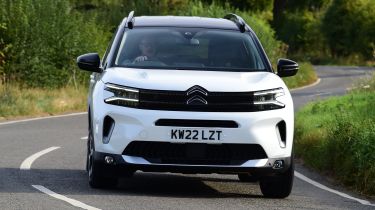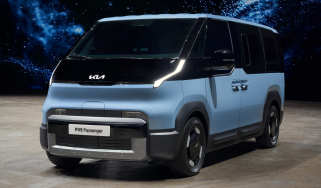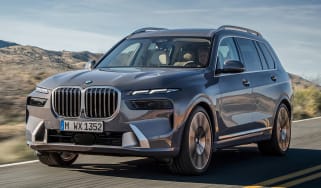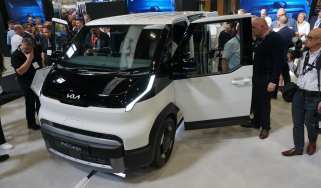Citroen C5 Aircross - Engines, performance and drive
The Citroen C5 Aircross is built with comfort in mind rather than excitement

Citroen’s unique approach to developing the C5 Aircross doesn’t just extend to the exterior design, as every variant benefits from Citroen’s Progressive Hydraulic Cushion suspension. The suspension works by replacing the usual bump stops with a pair of hydraulic dampers, and the theory is that it will make the C5 Aircross feel like a Citroen from the days when cars carrying the double chevrons were famous for gliding over bumps.
Of more concern is that the C5 Aircross thumps into even mild potholes and bumps, sending a nasty shiver through the car’s body. The effect is that the Aircross’s suspension manages to tell you about bumps you might not even see – which is confusing given that you’re unlikely to feel them through the numb steering. While not full of feel, that steering is at least light, and the turning circle is usefully tight.
The Aircross is fitted with Advanced Comfort Seats; they’re a strange mixture of plenty of under-thigh support but little to keep you in place laterally when the car turns. Driven briskly through bends, they compound the problem of the softer suspension that has you swaying this way and that. On the plus side, the driving position is decent enough, and reasonable visibility and large door mirrors make manoeuvring easy.
What is the Citroen C5 Aircross like to drive?
In town
It’s a large car, but the Citroen C5 Aircross is easy enough to manoeuvre and park on smaller roads. If you find yourself sitting in traffic more often than you’d like, opting for one of the hybrid models will make this a much quieter affair, as these are programmed to run on electric power as much as possible. Naturally, this also makes them more efficient..
On A- and B-roads
Approach a backroad bend too quickly, and it’s here where you’ll pay the price for the Citroen C5 Aircross’ compliant ride. While it doesn’t feel like it’s lacking in grip, the soft and floaty suspension means you’ll quickly become very well acquainted with your passenger or door, depending on which direction you turn the wheel due to the body lean. Ease off the throttle, and body movements are slightly less dramatic.
On the motorway
At a 70mph cruise, the C5 Aircross rides exactly as advertised, gliding along with occupants completely cocooned from the outside world. Refinement is excellent, too, thanks to its acoustic windscreen and extra sound-proofing crammed into the engine bay that ensure things remain seriously serene.
0-62mph acceleration and top speed
The C5 Aircross Hybrid (which is actually a mild-hybrid) uses a 136bhp PureTech petrol engine mated to an electric motor to boost efficiency. This powertrain manages to run purely on electricity at very low speeds, which is particularly beneficial in traffic. It’s not exactly a performance car, because it’ll take 10.2 seconds to reach 62mph from a standstill.
Used - available now

2023 Citroen
C5 Aircross
16,915 milesAutomaticPetrol1.6L
Cash £19,103
2020 Citroen
C5 Aircross
46,164 milesAutomaticPetrol1.2L
Cash £14,303
2023 Citroen
C5 Aircross
16,720 milesManualPetrol1.2L
Cash £17,548
2021 Citroen
C5 Aircross
41,347 milesAutomaticDiesel1.5L
Cash £14,800While it works well enough, the hybrid system can make some very unusual and slightly unnerving whining noises. The petrol engine is fairly quiet when it does kick in, unless you have your foot to the floor, and the six-speed dual-clutch gearbox is reasonably responsive.
If you prefer the more traditionally frugal choice, the C5 Aircross is still available with diesel power. The 131bhp 1.5-litre BlueHDi engine is perky when it comes to performance, and it’ll cover the 0-62mph sprint in 10.6 seconds. Noise levels remain well subdued thanks to extra sound proofing under the bonnet.
The 1.2-litre, three-cylinder PureTech petrol also develops 131bhp, and this is slightly faster than the diesel with an official 0-62mph time of 10.5 seconds.
The most efficient model in the C5 Aircross line-up is the 224bhp PureTech plug-in hybrid. This consists of a 1.6-litre petrol engine and an electric motor that’s powered by a 13.2kW battery. This allows the PHEV to cover up to 36 miles on pure-electric power. It’s also the fastest C5 Aircross with a 0-62mph time of 8.7 seconds and 140mph top speed.
| Model | Power | 0-62mph | Top speed |
| C5 Aircross Puretech 130 S&S 6-speed manual | 131bhp | 10.5s | 121mph |
| C5 Aircross BlueHDI 130 S&S EAT8 Automatic | 131bhp | 10.6s | 117mph |
| C5 Aircross Plug-in Hybrid 225 | 224bhp | 8.7s | 140mph |









